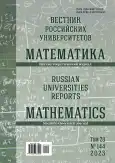On the role of Lagrange multipliers and duality in ill-posed problems for constrained extremum. To the 60th anniversary of the Tikhonov regularization method
- Authors: Sumin M.I.1
-
Affiliations:
- Derzhavin Tambov State University
- Issue: Vol 28, No 144 (2023)
- Pages: 414-435
- Section: Original articles
- URL: https://journal-vniispk.ru/2686-9667/article/view/296482
- DOI: https://doi.org/10.20310/2686-9667-2023-28-144-414-435
- ID: 296482
Cite item
Full Text
Abstract
The important role of Lagrange multipliers and duality in the theory of ill-posed problems for a constrained extremum is discussed. The central attention is paid to the problem of stable approximate finding of a normal (minimum in norm) solution of the operator equation of the first kind $Az=u,$ $z\in {\cal D}\subseteq Z,$ where $A:\,Z\to U$ is a linear bounded operator, $u\in U$ is a given element,
${\cal D}\subseteq Z$ is a convex closed set, $Z,U$ are Hilbert spaces. As is known, this problem is classical for the theory of ill-posed problems. We consider two problems equivalent to it (from the point of view of the simultaneous existence of their unique solutions) for a constrained extremum, the first of which is the problem ($CE1$) with a functional inequality constraint $\|z\|^2\to\min,$ $\|Az-u\|^2\leq 0,$ $z\in {\cal D},$ and the second is the problem ($CE2$) with operator equality constraint $\|z\|^2\to\min,$ $Az=u,$ $z\in {\cal D}.$ First of all, we show that Tikhonov's regularization method can be naturally interpreted as a method of stable approximation of the exact solution by extremals of the Lagrange functional for problem ($CE1$) with simultaneous construction of a maximizing sequence of Lagrange multipliers in its dual problem. In this case, the Lagrange multiplier is the reciprocal of the regularization parameter in the Tikhonov method. In other words, the convergence theorem of the Tikhonov regularization method is given the form of a statement in the form of duality with respect to the problem ($CE1$). Next, we discuss the role of Tikhonov stabilization for general convex problems in solving problems for constrained extremum and a stable method based on Tikhonov stabilization of the problem dual to ($CE2$) for solving the original operator equation, which can be considered as a regularization method for the Lagrange multiplier rule for the problem ($CE2$). The paper discusses the features of each of the two above mentioned approaches to the regularization of solving the original operator equation.
About the authors
Mikhail I. Sumin
Derzhavin Tambov State University
Author for correspondence.
Email: m.sumin@mail.ru
ORCID iD: 0000-0002-3700-6428
Doctor of Physics and Mathematics, Chief Researcher
Russian Federation, 33 Internatsionalnaya St., Tambov 392000, Russian FederationReferences
- A.N. Tikhonov, “Solution of incorrectly formulated problems and the regularization method”, Sov. Math., Dokl., 4 (1963), 1035–1038.
- A.N. Tikhonov, “Regularization of incorrectly posed problems”, Sov. Math., Dokl., 4 (1963), 1624–1627.
- A.N. Tikhonov, V.Ya. Arsenin, Solutions of Ill-Posed Problems, Winston; Halsted Press, Washington; New York, 1977.
- Il-posed Problems in the Natural Science, Advances in Science and Technology in the USSR Mathematics and Mechanics, eds. A.N. Tikhonov, A.V. Goncharskii, Mir Publ., Moscow, 1989.
- V.K. Ivanov, V.V. Vasin, V.P. Tanana, Theory of Linear Ill-Posed Problems and its Applications. V. 36, Inverse and Ill-Posed Problems, Walter de Gruyter, Utrecht, 2002.
- A.N. Tikhonov, A.V. Goncharskii, V.V. Stepanov, A.G. Yagola, Regularizing Algorithms And Apriori Information, Nauka Publ., Moscow, 1983 (In Russian).
- A.B. Bakushinskii, A.V. Goncharskii, Incorrect Tasks. Numerical Methods and Applications, Publishing House Moscow University, Moscow, 1989 (In Russian).
- F.P. Vasil’ev, Optimization Methods: in 2 books, MCCME, Moscow, 2011 (In Russian).
- M.I. Sumin, Incorrect Problems and Methods for Solving Them. Materials for Lectures for Students Senior Students, Publishing House of Nizhny Novgorod State University, Nizhny Novgorod, 2009 (In Russian).
- M.I. Sumin, “Lagrange principle and its regularization as a theoretical basis of stable solving optimal control and inverse problems”, Vestnik rossiyskikh universitetov. Matematika = Russian Universities Reports. Mathematics, 26:134 (2021), 151–171 (In Russian).
- M.I. Sumin, “On ill-posed problems, extremals of the Tikhonov functional and the regularized Lagrange principles”, Vestnik rossiyskikh universitetov. Matematika = Russian Universities Reports. Mathematics, 27:137 (2022), 58–79 (In Russian).
- M.I. Sumin, “Duality-based regularization in a linear convex mathematical programming problem”, Comput. Math. Math. Phys., 47:4 (2007), 579–600.
- A.N. Tikhonov, “On the stability of the functional optimization problem”, U.S.S.R. Comput. Math. Math. Phys., 6:4 (1966), 28–33.
- M.I. Sumin, “Regularized parametric Kuhn–Tucker theorem in a Hilbert space”, Comput. Math. Math. Phys., 51:9 (2011), 1489–1509.
- M.I. Sumin, “Stable sequential convex programming in a Hilbert space and its application for solving unstable problems”, Comput. Math. Math. Phys., 54:1 (2014), 22–44.
- M.I. Sumin, “Why regularization of Lagrange principle and Pontryagin maximum principle is needed and what it gives”, Vestnik Tambovskogo universiteta. Seriya: estestvennye i tekhnicheskie nauki = Tambov University Reports. Series: Natural and Technical Sciences, 23:124 (2018), 757–772 (In Russian).
- M.I. Sumin, “Regularized Lagrange principle and Pontryagin maximum principle in optimal control and in inverse problems”, Trudy Inst. Mat. i Mekh. UrO RAN, 25, 2019, 279–296 (In Russian).
- V.M. Alekseev, V.M. Tikhomirov, S.V. Fomin, Optimal Control, Plenum Press, New York, 1987.
- M.I. Sumin, “Nondifferential Kuhn–Tucker theorems in constrained extremum problems via subdifferentials of nonsmooth analysis”, Vestnik rossiyskikh universitetov. Matematika = Russian Universities Reports. Mathematics, 25:131 (2020), 307–330 (In Russian).
- J.-P. Aubin, L’Analyse non Linґeaire et ses Motivations ґ Economiques, Elsevier Masson, Paris–New York, 1984.
- J. Warga, Optimal Control of Differential and Functional Equations, Academic Press, New York, 1972.
- M.I. Sumin, “On regularization of the classical optimality conditions in convex optimal control problems”, Trudy Inst. Mat. i Mekh. UrO RAN, 26, 2020, 252–269 (In Russian).
Supplementary files








